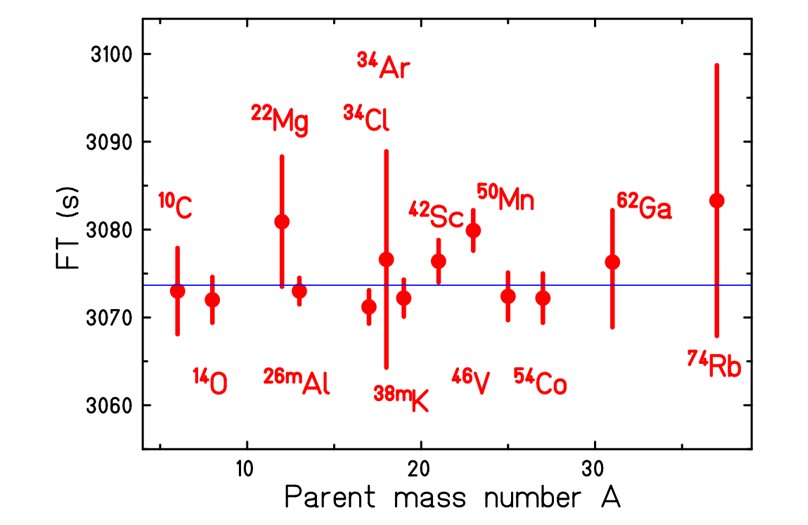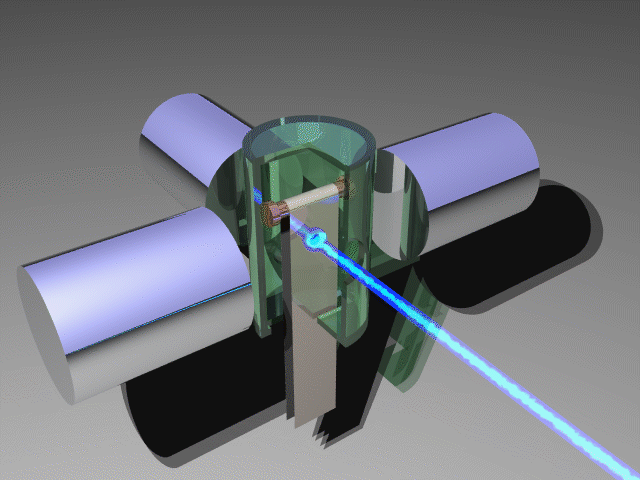Partenaires
Super-allowed 0+ -> 0+ beta decays
Physics case
The standard model of the electro-weak interaction can be nicely tested by high-precision measurements of super-allowed Fermi beta decays. These transitions are intrinsically simple and can therefore be precisely described by theory. However, as these decays take place in the nuclear medium, corrections are necessary in order to compare the predictions from theory with the high-precision results from experiment.
The relative precision needed for the ft value of the beta decay, to permit a meaningful comparison between theory and experiment, is about 10-3 - 10-4. To achieve this, the beta-decay Q value, the beta-decay half-life and the super-allowed branching ratio all have to be measured with this precision. This goal has been achieved to date for 13 nuclei (see Fig. 1), ranging from 10C to 74Rb. Today, the limiting factor in the comparison between theory and experiment are the corrections required to translate the ft values for individual nuclei to universal Ft values, which are independent of the nuclear medium. Two important components to this correction are i) a radiative correction due, for example, to the interaction of the emitted positron with the charge of the nucleus, and ii) an isospin breaking correction due to nuclear structure:

Having a universal Ft value would confirm the standard model hypothesis of a conservation of the vector current in weak interactions, characterized by a unique weak vector coupling constant G’2V. Comparing the value of G’2V in nuclear beta decay and in the purely leptonic decay of the muon, the Vud matrix element of the Cabbibo-Kobayashi-Maskawa quark mixing matrix can be determined, and the unitarity of the CKM matrix can be addressed.
The term (![]() NS -
NS - ![]() c) in the above equation for the universal Ft value is the dominant source of error in the comparison with theory. It can be tested by measuring new super-allowed beta decays for heavier nuclei, where these corrections are predicted to become much more important. However, for heavier nuclei the predictions for these corrections also become more uncertain. This is no longer the case for the heaviest nuclei that can be used for these studies, namely 98In or 94Ag. In these cases, the corrections are again very reliable, as these nuclei are close to doubly-magic 100Sn, making shell-model calculations based on this core of modest dimension and thus quite reliable.
c) in the above equation for the universal Ft value is the dominant source of error in the comparison with theory. It can be tested by measuring new super-allowed beta decays for heavier nuclei, where these corrections are predicted to become much more important. However, for heavier nuclei the predictions for these corrections also become more uncertain. This is no longer the case for the heaviest nuclei that can be used for these studies, namely 98In or 94Ag. In these cases, the corrections are again very reliable, as these nuclei are close to doubly-magic 100Sn, making shell-model calculations based on this core of modest dimension and thus quite reliable.
The proton-rich nuclei to be studied (66As, 70Br, 78Y, 82Nb, 86Tc, 90Rh, 94Ag, 98In) will be produced either by the SPIRAL2 fusion-evaporation production cave (the "yellow" cave) or by S3 and its low-energy facility.
Instrumentation:
The setups used will be plastic scintillators and gas detector working in the Geiger regime to perform the half-life measurements as well as HPGe detectors calibrated with high precision for the branching ratio measurements.
The following figure shows such a device schematically.

Contact: Bertram Blank, Bordeaux


 To read, in the same section...
To read, in the same section...
- Trap-assisted conversion-electron spectroscopy , 17 June 2010.
- The TETRA setup , 28 June 2008.
- Beta Decay Total Absorption Spectrometer , 28 June 2008.
- Beta-delayed charged particle emission , 16 April 2008.